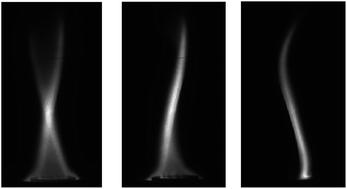当前位置:
X-MOL 学术
›
J. Anal. At. Spectrom.
›
论文详情
Our official English website, www.x-mol.net, welcomes your feedback! (Note: you will need to create a separate account there.)
Thomson scattering versus modeling of the microwave plasma torch: a long standing discrepancy almost solved
Journal of Analytical Atomic Spectrometry ( IF 3.4 ) Pub Date : 2020-08-27 , DOI: 10.1039/d0ja00161a Joost van der Mullen 1, 2, 3 , Mariana Atanasova 4, 5, 6, 7 , Adam Obrusník 8, 9, 10, 11 , Lenka Zajíčková 8, 9, 10, 11, 12
Journal of Analytical Atomic Spectrometry ( IF 3.4 ) Pub Date : 2020-08-27 , DOI: 10.1039/d0ja00161a Joost van der Mullen 1, 2, 3 , Mariana Atanasova 4, 5, 6, 7 , Adam Obrusník 8, 9, 10, 11 , Lenka Zajíčková 8, 9, 10, 11, 12
Affiliation

|
The characterization of plasmas gives much more insight if the results of modeling are compared with those of experiments. In the past, several modeling-experiment studies were performed on the microwave plasma torch (MPT). For the modeling a Global Plasma Model (GPM) was employed and for the experiment Thomson scattering (TS) was used. The same GPM-TS comparison was successfully applied to several other, more robust plasmas. However for the MPT it was found that the comparison led to severe discrepancies. The most salient feature was that the value of the electron temperature, Te, found by TS, was substantially higher than what GPMs predicted. Several attempts were undertaken to solve this problem by refining the model and its most important input: the gradient of the electron density. The attention for the model implied that the TS technique was not scrutinized sufficiently. Recently it was discovered that the outcome of TS is very sensitive to the spectral fitting procedure. In the past this was carried out by employing the calibrated intensity using Gaussian fitting. However, a procedure based on the fitting of the spectral shape by using modified Gaussian fitting gives better results and leads to a lower Te value, more in the range of the GPM results. This paper discusses the background of the GPM and gives the basis of TS fitting procedures and an analysis of the systematic error that can be made when TS is performed on filamentary MPT-like plasmas.
中文翻译:

汤姆森散射与微波等离子体炬的建模:一个长期存在的差异几乎得到了解决
如果将建模结果与实验结果进行比较,则等离子体的表征将提供更多的见识。过去,对微波等离子体炬(MPT)进行了一些建模实验研究。为了进行建模,采用了全球等离子体模型(GPM),而对于实验则采用了汤姆森散射(TS)。相同的GPM-TS比较已成功应用于其他几种更坚固的等离子体。但是,对于MPT,发现比较导致了严重的差异。最突出的特征是电子温度T e的值TS发现的,大大高于GPM的预期。通过完善模型及其最重要的输入:电子密度梯度,进行了数种尝试来解决此问题。对模型的关注表明,对TS技术的检查不够充分。最近发现,TS的结果对光谱拟合过程非常敏感。过去,这是通过使用高斯拟合采用校准强度来进行的。但是,通过使用改进的高斯拟合来拟合光谱形状的过程会产生更好的结果,并导致较低的T eGPM结果范围内的更多值。本文讨论了GPM的背景,并给出了TS拟合程序的基础,并分析了当在丝状MPT类血浆上进行TS时可能产生的系统误差。
更新日期:2020-09-02
中文翻译:

汤姆森散射与微波等离子体炬的建模:一个长期存在的差异几乎得到了解决
如果将建模结果与实验结果进行比较,则等离子体的表征将提供更多的见识。过去,对微波等离子体炬(MPT)进行了一些建模实验研究。为了进行建模,采用了全球等离子体模型(GPM),而对于实验则采用了汤姆森散射(TS)。相同的GPM-TS比较已成功应用于其他几种更坚固的等离子体。但是,对于MPT,发现比较导致了严重的差异。最突出的特征是电子温度T e的值TS发现的,大大高于GPM的预期。通过完善模型及其最重要的输入:电子密度梯度,进行了数种尝试来解决此问题。对模型的关注表明,对TS技术的检查不够充分。最近发现,TS的结果对光谱拟合过程非常敏感。过去,这是通过使用高斯拟合采用校准强度来进行的。但是,通过使用改进的高斯拟合来拟合光谱形状的过程会产生更好的结果,并导致较低的T eGPM结果范围内的更多值。本文讨论了GPM的背景,并给出了TS拟合程序的基础,并分析了当在丝状MPT类血浆上进行TS时可能产生的系统误差。



























 京公网安备 11010802027423号
京公网安备 11010802027423号